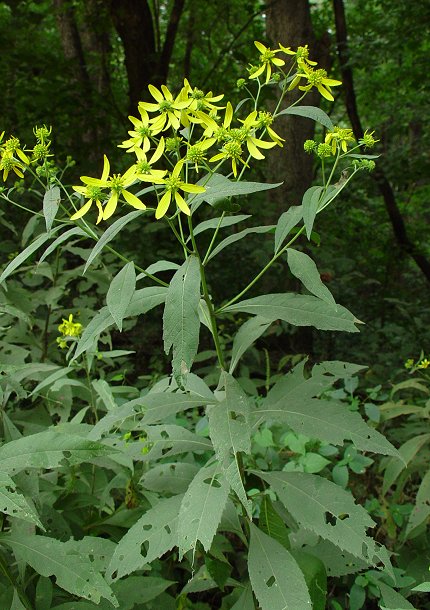Verbesina alternifolia (L.) Britton ex Kearney
Yellow Ironweed

Native
CC = 4
CW = -3
MOC = 76
© DETenaglia
Verbesina alternifolia (L.) Britton ex KearneyYellow Ironweed | |
 |
Native CC = 4 CW = -3 MOC = 76 |
© DETenaglia |
|
Family - Asteraceae/Heliantheae Habit - Perennial forb with fibrous, sometimes slightly fleshy roots and often stout rhizomes. Stems - Ascending to erect, to 2.5 m, narrowly and sometimes incompletely winged, often only below the midpoint, sparsely to moderately pubescent with short, spreading hairs, especially toward the tip, sometimes glaucous.To 3m tall, herbaceous, erect, multiple from the base, branching, winged, glaucous. Wings to +2mm broad, antrorse strigose on the margins, sparse pubescent.
Leaves - Alternate, or the lowermost leaves sometimes opposite, rarely nearly all opposite, simple, mostly sessile, the base usually minutely to strongly decurrent below the attachment point as a pair of wings. Blades 6-25 cm long, lanceolate to ovate, tapered at the base, tapered to a usually sharply pointed tip, the margins coarsely to finely toothed or sometimes nearly entire, the upper surface strongly roughened with sparse to moderate, short, spreading, pustular-based hairs, the undersurface similarly hairy, but often somewhat less roughened to the touch. Venation of blade expressed abaxially.
Inflorescence - Usually terminal panicles with 8-100 heads. Peduncles scabrous, antrorsely pubescent.
Heads - Involucre 10-14 mm in diameter, more or less saucer-shaped, with 8-12 bracts. Involucral bracts 3-8 mm long, linear to narrowly lanceolate or narrowly oblanceolate, spreading to reflexed at flowering, the outer surface moderately hairy. Chaffy bracts narrowly lanceolate to narrowly oblong-oblanceolate, sparsely to moderately hairy.
Florets - Ray florets 2-10, sterile, the corolla 10-25 mm long, drooping, yellow, glabrous, often apically notched. Disc florets 40-80, the corolla 3.5-4.5 mm long, yellow. Style bifurcate, with stigmas curling, slightly exserted. Pappus of the ray and disc florets similar (but that of the ray florets often slightly shorter and more flattened), of 2 slender awns 1.5-2.0 mm long, smooth or with fine, upward-pointed barbs, more or less persistent at fruiting.
Fruits - Spreading in all directions at maturity, 4-5 mm long, the body usually oblanceolate to broadly obovate, usually relatively broadly winged, less commonly narrowly winged or wingless, the surface glabrous or sparsely to moderately pubescent with fine, slightly pustular-based hairs.
Flowering - August - October. Habitat - Bottomlands, streambanks, sloughs, valleys and alluvial woods near streams, pastures, roadsides. Origin - Native to U.S. Lookalikes - Broadly, many other members of the family, but especially V. helianthoides and Rudbeckia laciniata. Potentially, V. occidentalis, a species not yet documented from Missouri. Other info. - This tall and showy species can be found throughout Missouri and is quite common. Its range extends to a broad swatch across the eastern half of the continental U.S., though it is less common near the northern and southern extents of the country. The plant is easy to identify in the field because of its winged stems, drooping rays, and hemispherical disks. It has a strong preference for riparian corridors and can nearly always be found in the rich bottomlands adjacent to streams and rivers. It is easily grown from seed and makes a great addition to the native plant garden. The flowers attract a profusion of insects. Photographs taken at the Current River Conservation Area, Reynolds County, MO., 8-10-01 (DETenaglia); also at Little Lost Creek Conservation Area, Warren County, MO, 9-6-2015, and along the Katy Trail southeast of Dutzow, Warren County, MO, 10-17-2019 (SRTurner). |